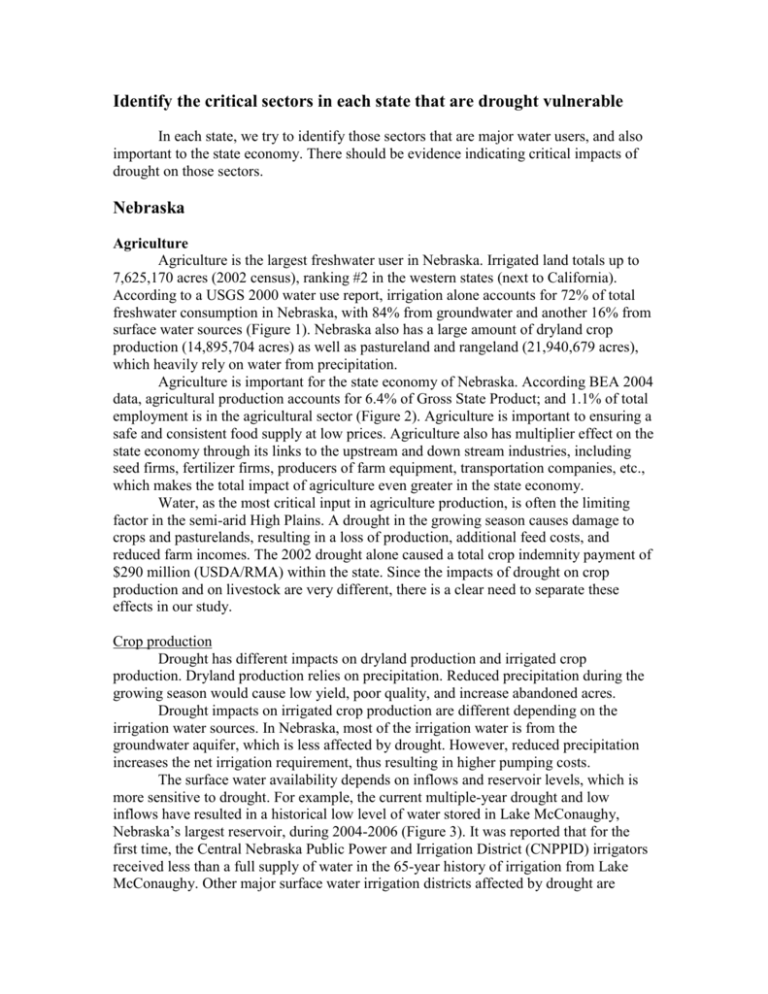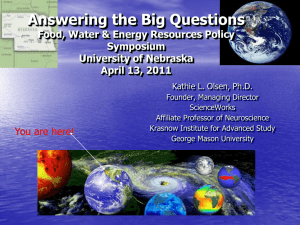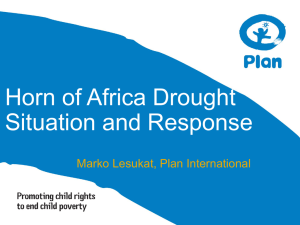Identify sub-sectors in Nebraska that could be impacted by drought
advertisement

Identify the critical sectors in each state that are drought vulnerable In each state, we try to identify those sectors that are major water users, and also important to the state economy. There should be evidence indicating critical impacts of drought on those sectors. Nebraska Agriculture Agriculture is the largest freshwater user in Nebraska. Irrigated land totals up to 7,625,170 acres (2002 census), ranking #2 in the western states (next to California). According to a USGS 2000 water use report, irrigation alone accounts for 72% of total freshwater consumption in Nebraska, with 84% from groundwater and another 16% from surface water sources (Figure 1). Nebraska also has a large amount of dryland crop production (14,895,704 acres) as well as pastureland and rangeland (21,940,679 acres), which heavily rely on water from precipitation. Agriculture is important for the state economy of Nebraska. According BEA 2004 data, agricultural production accounts for 6.4% of Gross State Product; and 1.1% of total employment is in the agricultural sector (Figure 2). Agriculture is important to ensuring a safe and consistent food supply at low prices. Agriculture also has multiplier effect on the state economy through its links to the upstream and down stream industries, including seed firms, fertilizer firms, producers of farm equipment, transportation companies, etc., which makes the total impact of agriculture even greater in the state economy. Water, as the most critical input in agriculture production, is often the limiting factor in the semi-arid High Plains. A drought in the growing season causes damage to crops and pasturelands, resulting in a loss of production, additional feed costs, and reduced farm incomes. The 2002 drought alone caused a total crop indemnity payment of $290 million (USDA/RMA) within the state. Since the impacts of drought on crop production and on livestock are very different, there is a clear need to separate these effects in our study. Crop production Drought has different impacts on dryland production and irrigated crop production. Dryland production relies on precipitation. Reduced precipitation during the growing season would cause low yield, poor quality, and increase abandoned acres. Drought impacts on irrigated crop production are different depending on the irrigation water sources. In Nebraska, most of the irrigation water is from the groundwater aquifer, which is less affected by drought. However, reduced precipitation increases the net irrigation requirement, thus resulting in higher pumping costs. The surface water availability depends on inflows and reservoir levels, which is more sensitive to drought. For example, the current multiple-year drought and low inflows have resulted in a historical low level of water stored in Lake McConaughy, Nebraska’s largest reservoir, during 2004-2006 (Figure 3). It was reported that for the first time, the Central Nebraska Public Power and Irrigation District (CNPPID) irrigators received less than a full supply of water in the 65-year history of irrigation from Lake McConaughy. Other major surface water irrigation districts affected by drought are located within the North Platte River Basin and Republican River Basin. The major source of irrigation water in the North Platte Basin is snow in Wyoming and Colorado. While, the other surface water projects are largely dependent on relatively local run-off from rainfall, or on base flow from groundwater. Therefore, drought impacts on irrigation water availability differ by the location and timing of drought. Livestock Livestock products account for about 2/3 of Nebraska’s farm income and beef cattle are the most important source. Nebraska ranks #2 among the states in total cattle inventory. Drought stressed pastures and rangelands cause poor grass growth. Producers have to pay high prices for supplement feed. A hay shortage in the local market would boost up hay prices. Poor pasture conditions and high feed costs force early marketing and culling, which would damp the market and result in low prices received by farmers. Because of the biological reproduction features of livestock industry, the impacts of drought would last for several years. Extra liquidation would hinder the rebuilding of cow herds and interrupt the normal cattle inventory cycle. For example, U.S. national cattle inventory data from USDA/NASS showed that the 2002 drought extended the otherwise 10-year cattle cycle to 14 years (1990-2004). Energy Hydropower electricity In Nebraska, the net electricity generation from hydropower averaged around 1.3 million Megawatt hours, accounting for only 0.2% of total hydroelectricity generation in U.S. The hydroelectricity generation data from 1990 through 2005 are plotted in Figure 4. Since 2001, the net hydroelectricity generation has been much reduced, and it might be due to drought. Thermoelectricity In Nebraska, thermoelectric plants use more surface water than irrigation (65% of total surface water). The water provides cooling for the plants. So, when the supply of water is limited, cooling costs go up and water reallocation has occurred as needed to meet electrical demand. Another concern with drought is the river’s temperature. Users of water must return it at about the same temperature it left the river, so it does not disrupt the ecology of the water plants and animals. So, when the river is already warm in drought, the power plants may have to cut back their generation. Recreation and tourism As there is no ski or rafting sites in Nebraska, the most water related recreation activities are fishing and boating; and the drought impacts are limited. Figure 5 plots Nebraska State park visits and revenue data from 1980 to 2003 (source: USDOC, Bureau of the Census).1 We can hardly detect the impacts of drought. 1 Ray suggests using Nebraska Game and Parks data directly, rather than USDOC data to look at localized drought impacts by major recreation facility. A severe localized drought impact may be important even though statewide effects may be offset by growth elsewhere. Most recreation users and visitors are in-state residents, who spend relatively little money on lodging and restaurants. So, the indirect impacts on the local economy are also small. Conclusion Based on above analysis, drought impacts are centered on the agriculture sector in Nebraska. There seems to be some impacts in the energy sector, but more information is needed before identification. Drought impacts on the recreation and tourism sector seems to be minor in Nebraska at state level. Other potential drought impacts that have been suggested include: environment, municipal water supply, health, and water quality. The potential impacts of drought in Nebraska on each are described in a little more detail below: 1) Environment: Difficult to measure impacts, but reduced flows could decrease habitat for fish, increase river temperatures, etc. 2) Municipal water supply: While the impacts are not going to be too extreme (i.e., there will always be drinking water, showers, etc.), there are municipalities that limit outdoor watering. For example, just a couple of days ago one town in Nebraska decided to ban lawn watering. There is certainly a loss in consumer surplus from such bans or limits. 3) Health: It’s unclear how drought would impact health. 4) Water quality: It’s unclear how drought would impact water quality significantly (at least not in a way that has an economic impact). But, this is something to consider. Some of these impacts might be big issues in Colorado or New Mexico, which need further investigations. Figure 1: Nebraska Freshwater Use Freshwater use by category, Nebraska 2000 (water use are in thousand acre-feet per year) Public Supply, 369.6, 3% Domestic, 54.2, 0% Thermoelectric, 3,158.8, 23% Industrial, 42.7, 0% Mining, 143.4, 1% Livestock, 104.6, 1% Irrigation, 9,846.1, 72% Groundwater use by category, Nebraska 2000 (water use are in thousand acre-feet per year) Livestock, 85.2, 1% Mining, 6.3, 0% Irrigation, 8,312.8, 95% Thermoelectric, 7.7, 0% Public Supply, 298.3, 3% Domestic, 54.3, 1% Industrial, 39.7, 0% Surface-water use by category, Nebraska 2000 (water use are in thousand acre-feet per year) Public Supply, 71.5, 1% Domestic, 0.0, 0% Industrial, 2.9, 0% Irrigation, 1,537.4, 31% Thermoelectric, 3,148.8, 65% Livestock, 19.5, 0% Mining, 136.7, 3% Figure 2: Nebraska Gross State Product and Employment by Industry Industry Com position_NE2004 Agriculture, 6.43% Government, 14.84% Minining&Constr uction, 4.49% Manufacturing, 10.62% Services, 21.27% Trans. & Util., 9.38% w holesale, 6.01% FIRE1, 16.86% Retail, 6.53% Information, 3.58% Nebraska Employment by Industry Government, 17.21% Agriculture, 1.12% Minining&Constr., 5.48% Manufacturing, 11.41% Trans. & Util., 4.29% Services, 34.52% w holesale, 4.64% Retail, 12.08% FIRE, 6.81% Information, 2.43% Figure 3: Lake McConaughy Elevation Figure 4: Hydroelectricity Generation in Nebraska Hydroelectricity Generation in Nebraska 2000000 1600000 1400000 1200000 1000000 800000 600000 400000 200000 Year 2005 2004 2003 2002 2001 2000 1999 1998 1997 1996 1995 1994 1993 1992 1991 0 1990 Thousand Megawatthours 1800000 Figure 5: Nebraska State Parks Visits and Revenue State Parks Visits and Revenue of Nebraska 12,000,000 10,000,000 6,000,000 4,000,000 2,000,000 Year Visitors Revenue 2002 2000 1998 1996 1994 1992 1990 1 1988 1986 1984 1982 0 1980 $ 8,000,000







